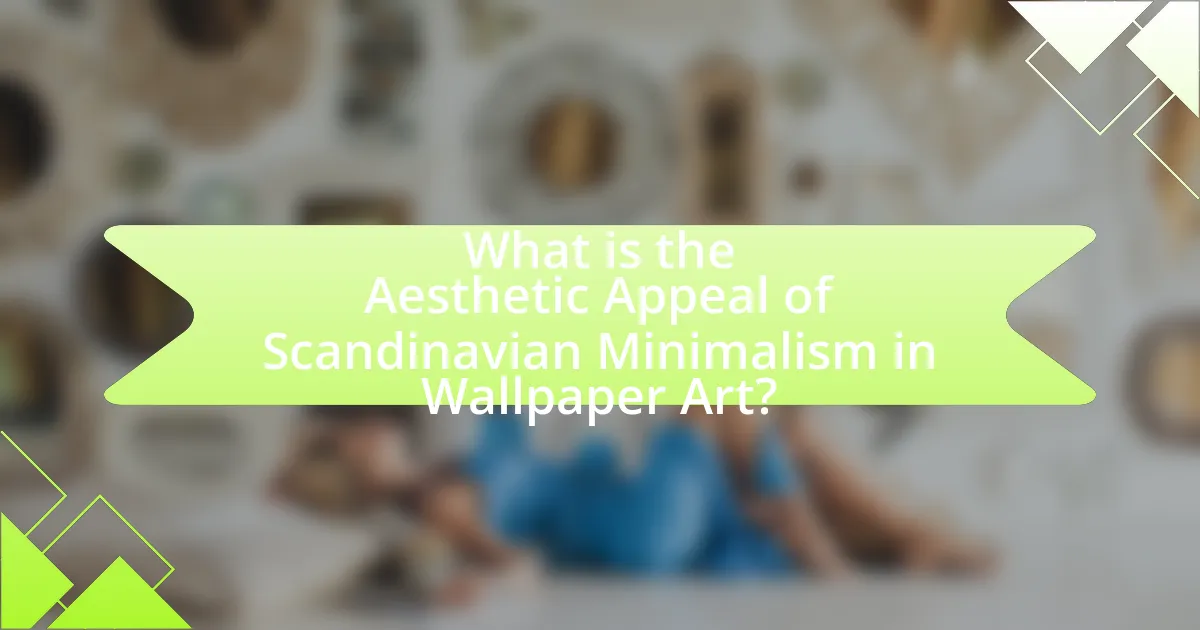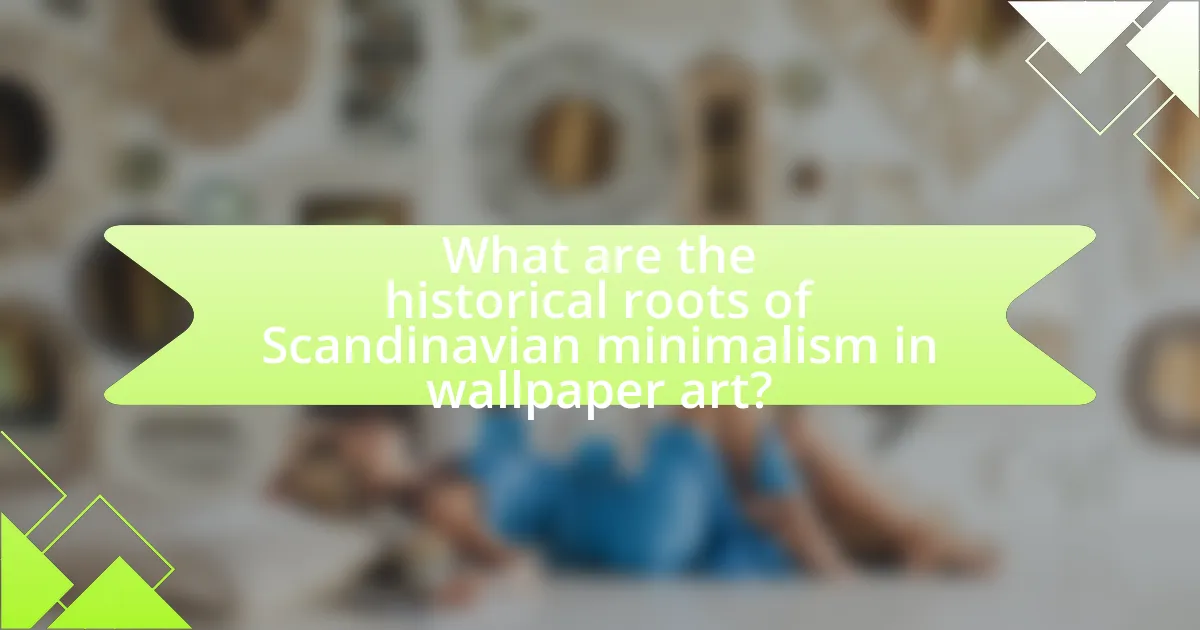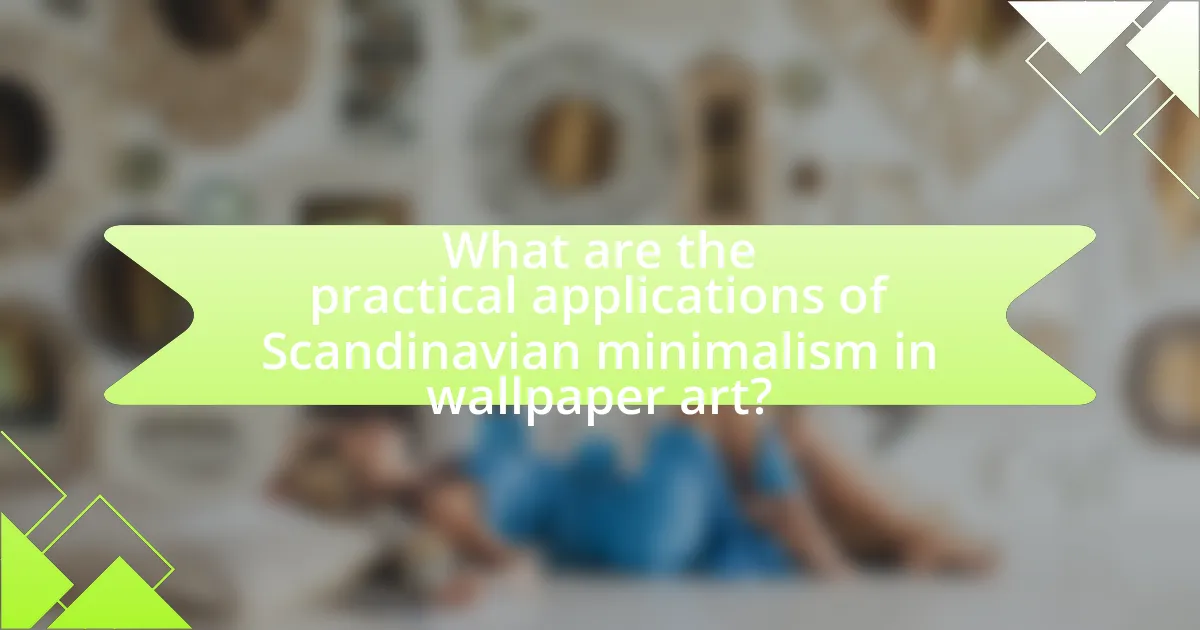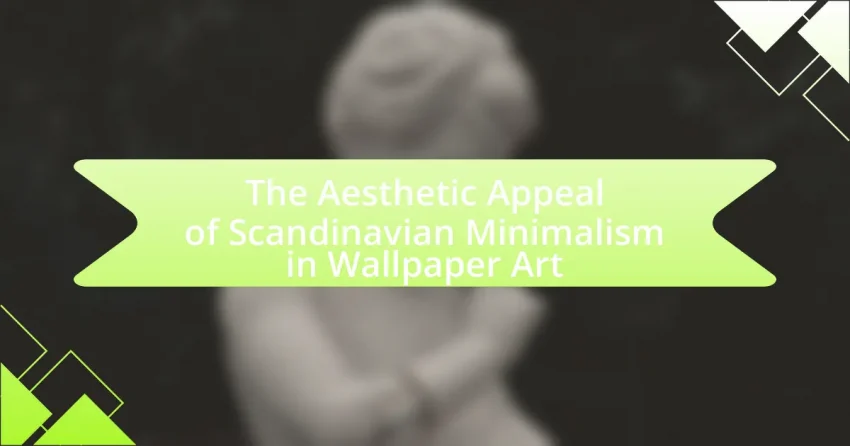The article explores the aesthetic appeal of Scandinavian minimalism in wallpaper art, highlighting its focus on simplicity, functionality, and natural elements. Key characteristics include clean lines, muted color palettes, and organic textures that create serene environments. The influence of Scandinavian design principles on wallpaper patterns, the role of color in enhancing tranquility, and the psychological effects of aesthetic appeal on individuals are discussed. Additionally, the article examines the historical roots of Scandinavian minimalism, contemporary design practices, and practical applications for homeowners looking to incorporate this style into their spaces.

What is the Aesthetic Appeal of Scandinavian Minimalism in Wallpaper Art?
The aesthetic appeal of Scandinavian minimalism in wallpaper art lies in its emphasis on simplicity, functionality, and natural elements. This design philosophy prioritizes clean lines, muted color palettes, and organic textures, creating a serene and uncluttered environment. Scandinavian minimalism often incorporates motifs inspired by nature, such as flora and fauna, which enhances the connection to the outdoors and promotes a sense of tranquility. The use of high-quality materials and craftsmanship further elevates the visual impact, ensuring that the wallpaper not only serves a decorative purpose but also contributes to a harmonious living space. This approach aligns with the broader Scandinavian design ethos, which values sustainability and the beauty of simplicity, making it a timeless choice for interior decor.
How does Scandinavian minimalism influence wallpaper design?
Scandinavian minimalism significantly influences wallpaper design by emphasizing simplicity, functionality, and natural elements. This design philosophy prioritizes clean lines, muted color palettes, and organic textures, which are reflected in wallpaper patterns that often feature geometric shapes and subtle motifs. For instance, many Scandinavian wallpaper designs utilize soft hues like whites, grays, and pastels, creating a serene atmosphere that aligns with the minimalist ethos. Additionally, the use of sustainable materials in wallpaper production is a direct manifestation of Scandinavian values, promoting eco-friendliness alongside aesthetic appeal. This approach not only enhances the visual space but also fosters a sense of calm and order, which is central to Scandinavian interior design principles.
What are the key characteristics of Scandinavian minimalism in wallpaper art?
Scandinavian minimalism in wallpaper art is characterized by simplicity, functionality, and a focus on natural elements. This design approach emphasizes clean lines, muted color palettes, and organic patterns that evoke a sense of calm and tranquility. The use of materials that reflect nature, such as wood and stone textures, further enhances the aesthetic, promoting a connection to the outdoors. Additionally, Scandinavian minimalism often incorporates geometric shapes and subtle motifs, ensuring that the designs remain understated yet visually engaging. This style aligns with the broader Scandinavian design philosophy, which values practicality and beauty in everyday objects.
How does color play a role in Scandinavian minimalist wallpaper?
Color plays a crucial role in Scandinavian minimalist wallpaper by emphasizing simplicity and creating a serene atmosphere. The use of muted tones, such as soft whites, grays, and pastels, aligns with the Scandinavian design philosophy that values natural light and a sense of calm. This color palette not only enhances the spaciousness of interiors but also promotes a harmonious connection with nature, reflecting the region’s landscapes. Research indicates that these color choices contribute to psychological well-being by reducing stress and fostering tranquility in living spaces.
Why is aesthetic appeal important in wallpaper art?
Aesthetic appeal is important in wallpaper art because it significantly influences the overall ambiance and emotional response of a space. Wallpaper serves not only as a decorative element but also as a means of expressing personal style and enhancing the visual harmony of interiors. For instance, studies show that environments with aesthetically pleasing designs can improve mood and productivity, highlighting the psychological impact of visual elements in living and working spaces. In Scandinavian minimalism, the emphasis on simplicity and functionality further underscores the importance of aesthetic appeal, as it creates a serene atmosphere that promotes well-being and mindfulness.
How does aesthetic appeal affect interior design choices?
Aesthetic appeal significantly influences interior design choices by guiding the selection of colors, materials, and layouts that create a desired visual impact. For instance, in Scandinavian minimalism, which emphasizes simplicity and functionality, the aesthetic appeal is rooted in clean lines, neutral palettes, and natural materials, leading designers to prioritize these elements to evoke a sense of calm and spaciousness. Research indicates that environments designed with aesthetic considerations can enhance mood and well-being, as seen in studies showing that well-designed spaces can improve productivity and reduce stress levels. Therefore, the aesthetic appeal not only shapes the visual aspects of interior design but also affects the psychological and emotional responses of individuals within those spaces.
What psychological effects does aesthetic appeal have on individuals?
Aesthetic appeal significantly influences individuals’ psychological states by enhancing mood, increasing satisfaction, and promoting well-being. Research indicates that exposure to aesthetically pleasing environments can lead to positive emotional responses, such as happiness and relaxation. For instance, a study published in the Journal of Environmental Psychology found that individuals exposed to beautiful designs reported lower stress levels and higher levels of life satisfaction. Furthermore, aesthetic appeal can enhance cognitive performance, as environments that are visually appealing can improve focus and creativity, as demonstrated in research by the University of Michigan, which showed that participants in aesthetically pleasing settings performed better on tasks requiring attention and problem-solving.

What are the historical roots of Scandinavian minimalism in wallpaper art?
Scandinavian minimalism in wallpaper art has its historical roots in the early 20th century, particularly influenced by the Bauhaus movement and Nordic design principles that emphasized simplicity and functionality. The Bauhaus, founded in 1919, promoted a design philosophy that rejected ornamentation and focused on clean lines and geometric forms, which resonated with Scandinavian designers. This led to the development of wallpaper designs that featured muted colors, organic shapes, and natural motifs, reflecting the region’s connection to nature and the desire for harmony in living spaces. Additionally, the post-World War II era saw a rise in the popularity of minimalism as a reaction against the excesses of previous design trends, further solidifying the aesthetic of Scandinavian wallpaper art as one that values simplicity, practicality, and a serene atmosphere.
How did Scandinavian design principles evolve over time?
Scandinavian design principles evolved over time through a blend of functionality, simplicity, and a focus on natural materials. Initially influenced by the Arts and Crafts movement in the late 19th century, Scandinavian design emphasized craftsmanship and the beauty of natural forms. By the mid-20th century, the principles became more defined with the emergence of modernism, characterized by minimalism and the integration of form and function, as seen in the works of designers like Alvar Aalto and Arne Jacobsen. The post-World War II era further propelled these principles, as the need for affordable, practical design led to innovations in mass production while maintaining aesthetic quality. This evolution reflects a continuous dialogue between tradition and modernity, resulting in a design ethos that values simplicity, sustainability, and a connection to nature, which remains influential in contemporary design practices.
What cultural influences shaped Scandinavian minimalism?
Scandinavian minimalism is shaped by cultural influences such as Nordic design principles, the philosophy of hygge, and the region’s natural environment. Nordic design emphasizes functionality, simplicity, and a connection to nature, which is evident in the clean lines and uncluttered spaces characteristic of Scandinavian interiors. The concept of hygge, originating from Denmark, promotes coziness and contentment, further influencing minimalist aesthetics by prioritizing comfort and warmth in design. Additionally, the natural environment, including the use of light and materials like wood and stone, plays a crucial role in creating serene and harmonious spaces that reflect the simplicity and beauty of the Scandinavian landscape.
How did historical events impact the development of wallpaper art in Scandinavia?
Historical events significantly influenced the development of wallpaper art in Scandinavia by shaping cultural aesthetics and production techniques. The Industrial Revolution in the 19th century introduced mechanized printing methods, allowing for mass production of wallpaper, which made it more accessible to the general public. Additionally, the rise of nationalism in the late 19th and early 20th centuries led to a revival of traditional Scandinavian motifs and designs, reflecting local heritage and identity in wallpaper patterns. This period saw the incorporation of natural elements and minimalist designs, aligning with the broader Scandinavian design ethos that values simplicity and functionality. The impact of these historical events is evident in the evolution of wallpaper art, which transitioned from ornate styles to the clean lines and understated elegance characteristic of Scandinavian minimalism.
What role do contemporary designers play in Scandinavian wallpaper art?
Contemporary designers play a crucial role in Scandinavian wallpaper art by innovating and redefining traditional aesthetics through minimalism and functionality. They incorporate natural elements, geometric patterns, and a muted color palette, which are hallmarks of Scandinavian design, to create wallpapers that enhance interior spaces while maintaining simplicity. For instance, designers like Marimekko and Boråstapeter have successfully blended modern techniques with cultural motifs, resulting in products that resonate with both contemporary and traditional sensibilities. This approach not only preserves the essence of Scandinavian design but also adapts it to current trends, ensuring its relevance in the global market.
Who are the leading contemporary designers in Scandinavian wallpaper art?
The leading contemporary designers in Scandinavian wallpaper art include Boråstapeter, Sandberg Wallpaper, and Ferm Living. Boråstapeter is known for its innovative designs that blend traditional craftsmanship with modern aesthetics, while Sandberg Wallpaper emphasizes nature-inspired patterns and sustainable production methods. Ferm Living focuses on minimalist designs that reflect Scandinavian simplicity and functionality. These designers exemplify the aesthetic appeal of Scandinavian minimalism in wallpaper art through their unique approaches and commitment to quality.
How do modern techniques enhance traditional Scandinavian designs?
Modern techniques enhance traditional Scandinavian designs by integrating advanced printing technologies and sustainable materials, which improve both aesthetic quality and environmental impact. For instance, digital printing allows for intricate patterns and vibrant colors that were previously difficult to achieve with traditional methods. Additionally, the use of eco-friendly inks and recyclable substrates aligns with the Scandinavian ethos of sustainability, making designs not only visually appealing but also responsible. This combination of innovation and tradition results in wallpaper art that maintains the minimalist charm of Scandinavian design while appealing to contemporary sensibilities.

What are the practical applications of Scandinavian minimalism in wallpaper art?
Scandinavian minimalism in wallpaper art is practically applied through the use of simple patterns, neutral color palettes, and functional designs that enhance interior spaces without overwhelming them. This approach emphasizes clean lines and natural materials, which contribute to a sense of calm and spaciousness in homes. For instance, wallpaper designs often feature geometric shapes or organic motifs that reflect the beauty of nature, aligning with the Scandinavian ethos of blending indoor and outdoor environments. Additionally, the practicality of these designs is evident in their versatility; they can be used in various settings, from residential to commercial spaces, promoting a cohesive aesthetic that prioritizes functionality and simplicity.
How can homeowners incorporate Scandinavian minimalist wallpaper into their spaces?
Homeowners can incorporate Scandinavian minimalist wallpaper into their spaces by selecting designs that feature simple patterns, neutral colors, and natural textures. These wallpapers often emphasize functionality and simplicity, aligning with the principles of Scandinavian design, which values clean lines and a clutter-free aesthetic. For instance, using a light-colored wallpaper with subtle geometric shapes can enhance the sense of space and light in a room, making it feel more open and inviting. Additionally, homeowners can pair these wallpapers with minimalistic furniture and decor to create a cohesive look that embodies the Scandinavian ethos of minimalism and functionality.
What tips can help in selecting the right Scandinavian wallpaper for a room?
To select the right Scandinavian wallpaper for a room, prioritize simplicity and functionality, as these are core principles of Scandinavian design. Choose wallpapers with light colors and natural patterns that evoke a sense of calm and spaciousness, aligning with the minimalist aesthetic. For instance, wallpapers featuring geometric shapes or botanical prints can enhance the room’s ambiance while maintaining a clean look. Additionally, consider the room’s lighting; natural light can enhance lighter wallpapers, making spaces feel larger and more inviting. Research indicates that Scandinavian design often emphasizes the use of sustainable materials, so opting for eco-friendly wallpaper can also reflect this ethos.
How does lighting affect the appearance of Scandinavian minimalist wallpaper?
Lighting significantly influences the appearance of Scandinavian minimalist wallpaper by altering its color perception and texture visibility. Natural light enhances the subtle hues and patterns typical of Scandinavian design, making them appear more vibrant and inviting. Conversely, artificial lighting can create shadows that may obscure the wallpaper’s details or change its color temperature, leading to a less accurate representation of the intended aesthetic. Studies indicate that the direction and intensity of light can affect how colors are perceived; for example, warm light can make cool tones appear muted, while bright, cool light can enhance the crispness of minimalist designs.
What are the common challenges when using Scandinavian minimalist wallpaper?
Common challenges when using Scandinavian minimalist wallpaper include limited color palettes, which can restrict design flexibility, and the potential for a stark or cold atmosphere if not balanced with warmer elements. Additionally, achieving the desired aesthetic often requires careful selection of patterns and textures, as overly busy designs can contradict the minimalist ethos. The application process can also be challenging, as precise alignment is crucial to maintain the clean lines characteristic of Scandinavian design. Lastly, maintenance can be a concern, as lighter colors may show dirt and wear more easily, necessitating more frequent cleaning or replacement.
How can one overcome design challenges with minimalist wallpaper?
To overcome design challenges with minimalist wallpaper, one should focus on selecting complementary colors and textures that enhance the overall aesthetic. For instance, using a neutral color palette allows the minimalist wallpaper to serve as a subtle backdrop, while incorporating natural materials like wood or stone can create visual interest without overwhelming the space. Research indicates that Scandinavian design emphasizes simplicity and functionality, which can guide choices in wallpaper patterns and colors to maintain a cohesive look. By prioritizing balance and harmony in design elements, one can effectively address challenges associated with minimalist wallpaper.
What maintenance tips are essential for preserving Scandinavian wallpaper art?
To preserve Scandinavian wallpaper art, it is essential to regularly clean the surfaces with a soft, dry cloth to remove dust and prevent buildup. Additionally, maintaining a stable indoor climate with controlled humidity levels between 40-60% helps prevent warping and fading of the wallpaper. Avoiding direct sunlight exposure is crucial, as UV rays can significantly degrade the colors and patterns over time. Using a gentle, pH-balanced cleaner for any stains ensures that the wallpaper’s integrity remains intact. These practices are supported by the fact that Scandinavian design emphasizes simplicity and longevity, making proper maintenance vital for preserving its aesthetic appeal.
What are the best practices for choosing Scandinavian minimalist wallpaper?
The best practices for choosing Scandinavian minimalist wallpaper include selecting neutral color palettes, opting for simple geometric patterns, and ensuring high-quality materials. Neutral colors like whites, grays, and soft pastels create a calm and airy atmosphere, which is a hallmark of Scandinavian design. Simple geometric patterns, such as stripes or dots, maintain the minimalist aesthetic while adding visual interest without overwhelming the space. High-quality materials, such as non-woven or vinyl wallpapers, ensure durability and ease of maintenance, aligning with the functional aspect of Scandinavian design. These practices are supported by the principles of Scandinavian minimalism, which emphasize simplicity, functionality, and a connection to nature.
